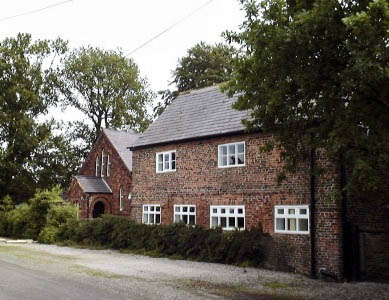MARBURY AND COMBERBACH ENVIRONS
Grid Ref: SJ 651 762
Dates: 6 July 2002 & 20 Feb 2015
Little remains of Marbury Hall near Great Budworth.
The following photographs were taken
on a cycle tour starting from Marbury and going round Comberbach.
The history of Marbury Hall is tied up with that of Belmont Hall which lies just to the NW of Great Budworth at SJ 654 784, about a mile and a quarter due north of the site of Marbury Hall. This is because at various times they were owned by the same family.
There have been several houses on the former site of Marbury Hall. The first was built by the Marbury family in the 13th century and they occupied it until the death of Richard Marbury in 1684 who was the last male heir. The property was then sold to Richard Savage, 4th Earl Rivers (c. 1654-1712) in 1708. The Savage family and some of their tombs are mentioned on one of my Macclesfield pages. Richard Savage was the second son of the 3rd Earl but when his elder brother, Thomas, died in 1680, Richard succeeded to the subsidiary title of Viscount Colchester until his father died 1694. Richard was a notorious rake but he entered parliament for Wigan in 1681 and became an officer in the Horseguards. Of interest to the history of England is that he was one of the first to join William of Orange when he landed in England in 1688. Subsequently he had a distinguished military career serving under the Duke of Marlborough in France. He became Constable of the Tower and in 1711 Master-General of the Ordnance.
Richard Savage married Penelope Downes and had a daughter Elizabeth who married the Irish peer, James Barry, 4th Earl of Barrymore (1667–1748). In addition Richard Savage had several illegitimate children, two by Anne, Countess of Macclesfield, occasioning her divorce in 1701. Having no legitimate male heir the earldom passed to the grandson of the 2nd Earl Rivers, who being a Roman Catholic Priest had no heirs and on his death in 1735 the Rivers Earldom became extinct.
The estate passed to Richard Savage's daughter and her husband, James Barry. He had been married first to Elizabeth Boyle the daughter of Charles Boyle, the 3rd Baron Clifford with whom he had one son, Richard who died in 1787, before his father, and two daughters. He then married Lady Elizabeth Savage and they had one daughter. James Barry, like his father-in-law, became an M.P. for Wigan in 1715. At the beginning of the 1715 Jacobite rebellion he was one of the officers who were dismissed or required to sell their regiments. Barry was one of the ten members of the Cheshire Club who narrowly decided not to join the Jacobite Thomas Forster, who was defeated by government forces at Preston. He was was also a leading Jacobite in the 1740s when he was involved in military discussions with English Jacobite leaders about a possible rebellion with French backing. When the rebellion of 1745 was defeated, Barrymore's treasonable actions were disclosed but the Government took no action against him. He died on 5 January 1748. A fuller account of his life is given in the article on History of Parliament site.
On the death of James Barry in 1748, the title went to a son James (1717-1751) the son of his third wife, Anne Chichester, whom he married after the death of Elizabeth Savage in 1714. James had the Irish family seat of Fota Island in County Cork. Marbury hall went to Richard Barry, a second brother who died without heirs in 1787.
There was a third brother, John Barry, who in 1746 married a wealthy Essex heiress, Dorothy Smith and thereupon changed his name to John Smith Barry. He purchased the site of Belmont Hall in 1749 and built a compact villa completed in 1755. He died in 1784 and his son, James Hugh Smith Barry (1746-1801) inherited Belmont Hall. Moreoverr as his uncle, Richard Barry, had no male heirs James Hugh Smith Barry inherited Marbury too in 1787.
His grandson James had the hall remodelled, in the French chateau style about 1856 by the architect Anthony Salvin (1799 – 1881). The house remained with the Smith-Barry family until it was sold in 1932 to become a country club.
The Barrymore
family have a number of monuments in the chapel
at the north side of the church at Great Budworth.
During the Second World War the estate was used as a military camp and for prisoners of war and ICI (Imperial Chemical Industries) used it as accommodation for Polish workers. The house was demolished in 1968 and the the estate became part of Marbury Country Park.
 |
|
 |
| The gate posts of Marbury Hall |
|
Cogshall Lodge |
 |
|
 |
The Friends Meeting House at Frandley
(SJ 636 793) |
|
Gable of the Meeting House with
outside staircase |
 |
|
 |
The Baptist Chapel at Crumley Heath
(Grid Ref. SJ 620 720) |
|
Little Leigh
(Grid Ref. SJ 615 760) |
Sources
Memorials of Old Cheshire by Edward Barber and the Rev. P. H. Ditchfield, George and Allen, 1910.
Wikipedia article on Marbury
Wikipedia on Richard Savage, 4th Earl Rivers.
History of Parliament site for 4th Earl of Barrymore
Cheshire Country Houses, by Peter de Figueiredo and Julian Treuherz, Phillimore Press, 1988, ISBN 0 85033 655 4





